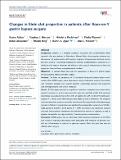Files in this item
Changes in fibrin clot properties in patients after Roux en-Y gastric bypass surgery
Item metadata
| dc.contributor.author | Abbas, Kazim | |
| dc.contributor.author | Hierons, Stephen J. | |
| dc.contributor.author | Pechlivani, Nikoletta | |
| dc.contributor.author | Phoenix, Fladia | |
| dc.contributor.author | Alexander, Robin | |
| dc.contributor.author | King, Rhodri | |
| dc.contributor.author | Ajjan, Ramzi A. | |
| dc.contributor.author | Stewart, Alan J. | |
| dc.date.accessioned | 2024-03-28T13:30:07Z | |
| dc.date.available | 2024-03-28T13:30:07Z | |
| dc.date.issued | 2024-02 | |
| dc.identifier | 299475578 | |
| dc.identifier | 7bdf8dec-ee2c-4d00-9910-7fef93cf9281 | |
| dc.identifier | 85188074818 | |
| dc.identifier.citation | Abbas , K , Hierons , S J , Pechlivani , N , Phoenix , F , Alexander , R , King , R , Ajjan , R A & Stewart , A J 2024 , ' Changes in fibrin clot properties in patients after Roux en-Y gastric bypass surgery ' , Research and Practice in Thrombosis and Haemostasis , vol. 8 , no. 2 , e102361 . https://doi.org/10.1016/j.rpth.2024.102361 | en |
| dc.identifier.issn | 2475-0379 | |
| dc.identifier.other | ORCID: /0000-0003-4580-1840/work/156133615 | |
| dc.identifier.uri | https://hdl.handle.net/10023/29568 | |
| dc.description.abstract | Background: Obesity is a complex condition associated with prothrombotic fibrin networks that are resistant to fibrinolysis. Altered fibrin clot properties enhance cardiovascular risk and associate with a poorer prognosis following acute ischemic events. Bariatric surgery is commonly employed to improve cardiometabolic outcomes in obese individuals. However, the effects of this surgical intervention on fibrin clot properties have not been comprehensively studied. Methods: The fibrin clot properties of 32 obese individuals before and 9-months after Roux en-Y gastric bypass (RYGB) surgery were determined using turbidimetric analysis. Correlation and regression analyses were used to identify relationships between clot properties and anthropomorphic and clinical measures. Results: RYGB surgery resulted in a significant reduction in adiposity-associated anthropometric measures as well as improvements in glycaemia and lipid profile. Clot maximum absorbance was reduced from 0.43 ± 0.11 at baseline to 0.29 ± 0.10 at 9 months post-surgery (p < 0.0001), while fibrin clot lysis time failed to show a difference. The change in maximum absorbance was not caused by alterations in fibrinogen levels, while PAI-1 concentration was significantly increased after surgery from 10,560 ± 6,681 pg/ml to 15,290 ± 6,559 pg/ml (p = 0.0093). Correlation and regression analysis indicated that maximum absorbance was influenced by markers of adiposity as well as HbA1c and hs-CRP concentrations. Conclusions: RYGB surgery led to a decrease in the maximum absorbance of the fibrin clot. Values of maximum absorbance were associated with measures of glycaemic control and inflammation. In contrast to previous reports, fibrin clot lysis time was not affected after surgery. | |
| dc.format.extent | 8 | |
| dc.format.extent | 870961 | |
| dc.language.iso | eng | |
| dc.relation.ispartof | Research and Practice in Thrombosis and Haemostasis | en |
| dc.subject | Fibrin network | en |
| dc.subject | Obesity | en |
| dc.subject | Gastric bypass | en |
| dc.subject | Thrombosis | en |
| dc.subject | Coagulation | en |
| dc.subject | RD Surgery | en |
| dc.subject | DAS | en |
| dc.subject | SDG 3 - Good Health and Well-being | en |
| dc.subject.lcc | RD | en |
| dc.title | Changes in fibrin clot properties in patients after Roux en-Y gastric bypass surgery | en |
| dc.type | Journal article | en |
| dc.contributor.institution | University of St Andrews. Cellular Medicine Division | en |
| dc.contributor.institution | University of St Andrews. School of Medicine | en |
| dc.contributor.institution | University of St Andrews. Sir James Mackenzie Institute for Early Diagnosis | en |
| dc.contributor.institution | University of St Andrews. Biomedical Sciences Research Complex | en |
| dc.contributor.institution | University of St Andrews. Institute of Behavioural and Neural Sciences | en |
| dc.identifier.doi | 10.1016/j.rpth.2024.102361 | |
| dc.description.status | Peer reviewed | en |
This item appears in the following Collection(s)
Items in the St Andrews Research Repository are protected by copyright, with all rights reserved, unless otherwise indicated.

